Who are we to laugh at the past?
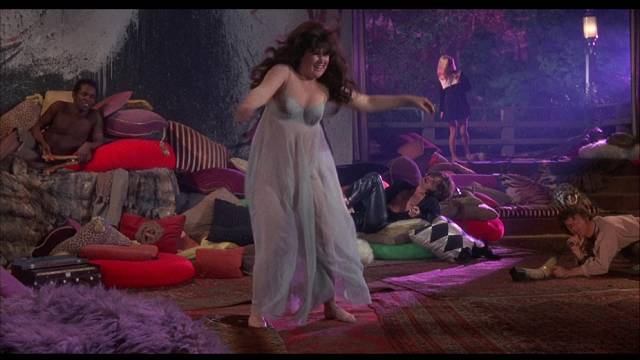
Every generation pushes back against the one which preceded it. Kids adopt styles to differentiate themselves from what came before; tastes are developed in part to offend, in part to find an identity separate from that of their parents. This process seems to be written in our genes, and enormous amounts of energy have been expended in an endless effort to suppress youthful rebellion, while equal amounts have been expended to throw off parental restraints. But if this has been going on since the species first emerged, it has been accelerated and made more pronounced since the arrival of what Walter Benjamin called “the age of mechanical reproduction”, particularly since the early 20th Century with the invention of record players, radios, movies and television … all more readily able to spread change than even the previous champion, the printing press.
The very nature of these technologies not only facilitates change; it also preserves a record of that change so that subsequent generations can look back and mock their own elders’ forms of rebellion. We all carry a certain amount of condescension towards our predecessors, mocking their naivete in the secure knowledge that we ourselves have finally attained some end-point in the development of knowledge and taste, certain that no one is destined to look back at us with that same condescension.
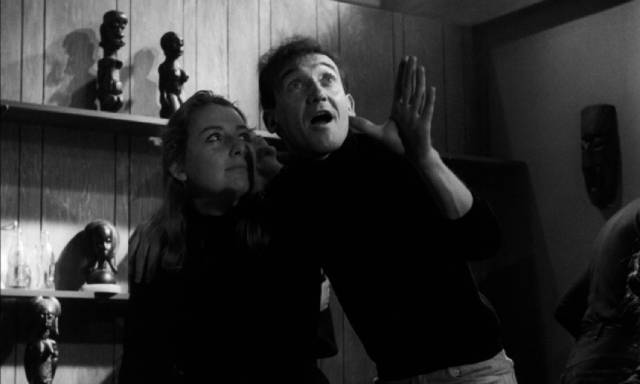
In movies, one of the most fertile periods for observing this process came in the post-war period, as the shadows of the war (on full display in the films noirs which seemed omnipresent from the mid-1940s to the early ’50s) gave way in the early ’50s to floods of exploitation movies aimed at newly affluent youths who were taking advantage of the massive social rupture produced by the war to rebel with a vengeance against their parents’ culture. Rock-and-roll, very much borrowed from Black culture, pumped energy into the rebellion, while a still conservative industry used it as a signifier of danger to the status quo. Movies fuelled by rock-and-roll focused at one end of the spectrum on the pain of kids oppressed by their parents’ outdated morality or at the other end, more conservatively, on kids unmoored from traditional morality and turning to crime and violence.
In the early 1950s, these conflicts could be taken seriously in movies like Nicholas Ray’s Rebel Without a Cause (1955), which established James Dean as the poster boy for tormented rebellion; but by the end of the decade an element of parody had already crept in, embodying or even mocking what was already something of a cliche, necessitating ever greater extremes which eventually pushed a gloss of social concern out in favour of outright nihilism. The latter grew in the ’60s against a background of the Vietnam War, breeding less sympathetic delinquents (like the pair who terrorize “normal” people on the New York subway in Larry Peerce’s The Incident [1967]) and gangs of violent bikers at war with society in movies like Roger Corman’s The Wild Angels (1966) and its imitators.
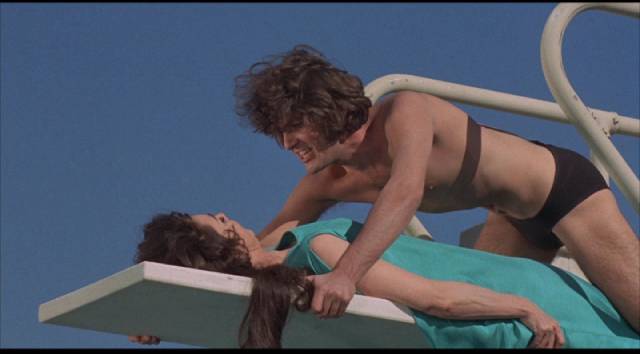
Parallel to this nihilism was the rise of the counterculture, rooted in sex and drugs as an escape from the social chaos of the period. Despite the opt-out philosophy of the Hippies, popular culture often viewed them with distrust … the mere act of rejecting conservative morality was seen as socially dangerous – the Summer of Love was to blame for the chaos of the anti-war movement. And perhaps even worse, all that drug use and uninhibited sex made the older generation’s locked down experience seem pretty miserable in comparison.
But as time passed, the rebels became the establishment and many disowned their own rebellion; the disruptions of the ’60s gave way to the money-grubbing conservatism of Reagan and his successors, the rampant idealization of greed and the political rot that has produced something in many ways far worse than the conformity of the ’50s. An air of melancholy hangs over much of the pop culture of those post-war decades; even the violence and rebellion seem naive now.
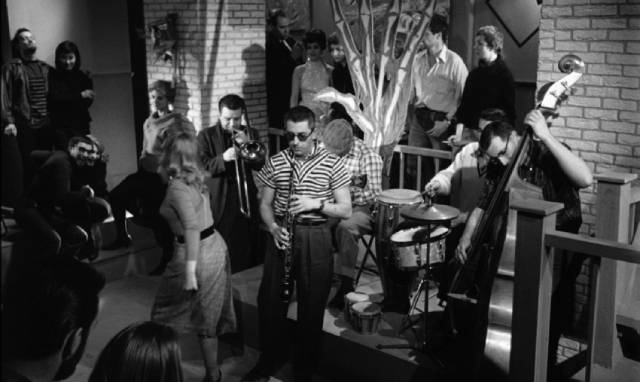
Before the Hippies, there were the Beatniks. While the former disengaged, the latter were defined by a rebellion given literary form – by Jack Kerouac, Allen Ginsberg, Lawrence Ferlinghetti and others. In pop culture, their milieu was coffee shops where music and poetry would break out spontaneously. With their black clothes, their berets and their apocalyptic poetry they reflected the fears of the Cold War and the Bomb, transforming their sense of imminent doom into an aesthetic which pointed towards individual liberation through a decisive rejection of an untenable status quo.
While the actual Beats addressed the world seriously in their writing, in movies they showed up as ready-made parodies of pretension who as often as not provided a front for drugs and crime – as in Jack Arnold’s High School Confidential (1958), in which an undercover cop infiltrates the kids’ hangouts to expose a marijuana racket[1]. Roger Corman mocked the popular image of the Beats with A Bucket of Blood (1959), in which the hapless coffee shop busboy Walter Paisley (the inimitable Dick Miller) inadvertently becomes a serial killer in his quest to be accepted by the pretentious “artists” who treat him with mocking contempt as he clears their tables.
*
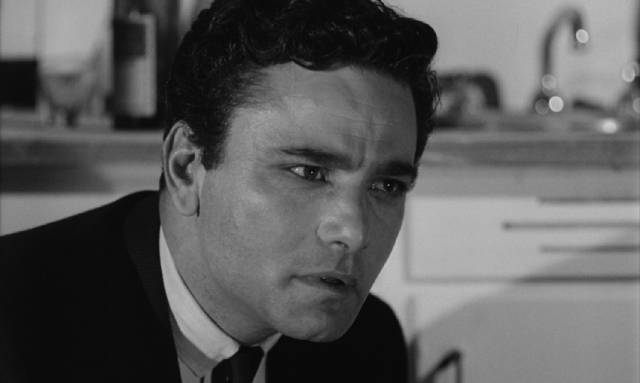
The Bloody Brood (Julian Roffman, 1959)
The same year, Canadian filmmaker Julian Roffman made what now plays like A Bucket of Blood without Walter Paisley. The Bloody Brood (1959) was the first of two features directed by Roffman, the other being Canada’s first 3D movie, The Mask (1961), which is better known because of the technical gimmick. It’s interesting to watch The Bloody Brood now because it was obviously intended as a serious film but can’t help but seem like pastiche from this distance.
As with so many movies of that period, the treatment of transgression and im-/amorality combines a relishing of bad behaviour with an ultimate condemnation of that same bad behaviour. The rules of the Production Code in the United States and the various censorship regimes in other countries (including Canada in this case) directed that all crime and misbehaviour must in the end be punished, a practice which audiences had long been used to and accepted as the price of enjoying the depiction of characters who could step outside of the limitations those audience members had to live with themselves.
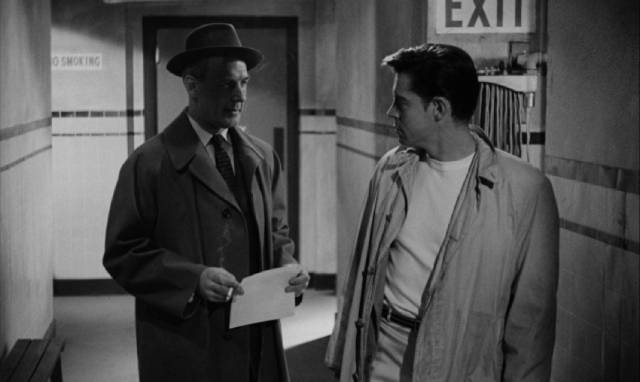
In The Bloody Brood there are two levels of transgression: the hedonistic behaviour of the Beatniks who spend their time making out at wild parties or playing bongos and spouting poetry at the coffee shop and the more malevolent actions of Nico who uses the partying as a cover for his drug distribution business, carried out under the auspices of the Mob. But Nico is more than just a dealer; he’s a flat-out sociopath who just for kicks decides to kill a stranger. The victim is a delivery boy who brings a telegram to an apartment where a wild party is happening while the owner is out of town. Nico lures the boy in and feeds him a hamburger laced with ground glass. The kid dies in agony while calling his older brother from a payphone.
That brother, Cliff (Jack Betts), dissatisfied with the police’s inability to find the killer, infiltrates the Beatniks’ lairs despite being an obvious “square”, gradually closing in on Nico and becoming involved with Ellie (Barbara Lord), whom he eventually manages to convince is living a misguided life.
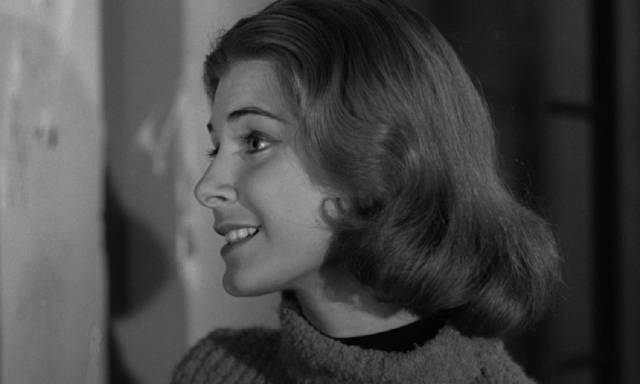
The movie doesn’t overtly preach against the debauched Beatnik lifestyle, but by showing it to be so easily used as a cover for Nico’s criminal activities, it comes down firmly on the side of the square Cliff, a decent guy making an honest living and offering Ellie the option of a respectable relationship. But as is so often the case, it’s the villain who stands out and holds the viewer’s attention. Nico was the first starring movie role for the thirty-two-year-old Peter Falk. Despite him trying to disown the movie later on, he displays an energy which adds some genuine dramatic power to what is essentially a throw-away B-movie; he relished the sinister side of Nico, mixing arrogance and insecurity into a dangerous blend which results in a particularly nasty, senseless killing.
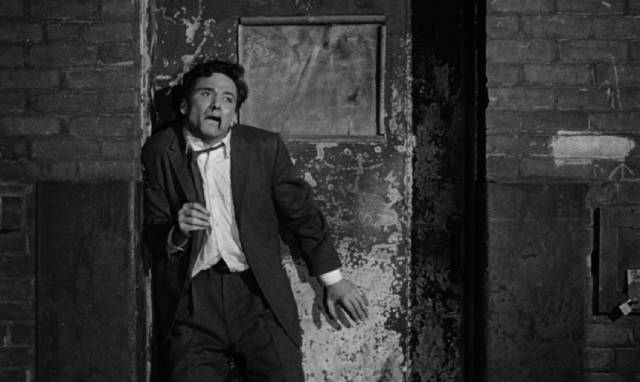
Set in a generic American city, possibly New York, The Bloody Brood was shot in Toronto by the great Eugen Schüfftan, whose career in cinematography spanned from Edgar G. Ulmer and Robert Siodmak’s Menschen am Sonntag (1930) to Conrad Rooks’ Chappaqua (1966), and was preceded by years of technical innovation in special effects during which he invented the Schüfftan matte process which enabled Fritz Lang, among others, to create imagery on an epic scale from the ’20s through the ’40s.
As for Roffmann, his two small features came after two decades of documentary work, beginning with a tenure at the National Film Board of Canada during the Second World War, and then moving between Canada and the U.S. making informational films with a lefty bent. The Kino Lorber Blu-ray includes a couple of these, one of which is an interesting direct attack on McCarthyite anti-Communist hysteria made in 1953. There’s also an interview with Roffman’s son and a commentary from Canadian exploitation authority Paul Corupe.
*
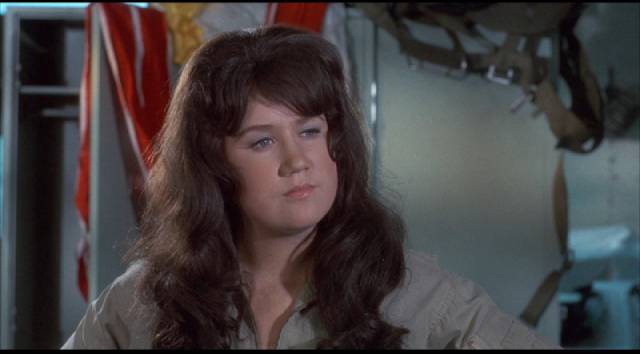
Cult of the Damned (Robert Thom, 1969)
In form, The Bloody Brood clearly fits into the ’50s juvenile delinquent mould, but the character of Nico looks ahead to the nascent nihilism of the ’60s. There is no attempt to psychologize the character, to find ways of understanding him like Jim Stark in Rebel Without a Cause or Johnny in The Wild One (1953); he’s like an alien creature intruding into the world. By the late ’60s, his nihilism seemed to have permeated the world, becoming the norm.
There’s a sourness to many movies made late in the decade. Oddly, some filmmakers found refuge in the past, seeking there a strange nostalgic reassurance in the face of contemporary chaos – Peckinpah in The Wild Bunch, Arthur Penn in Bonnie and Clyde, George Roy Hill in Butch Cassidy and the Sundance Kid – as if rebellion could only be embraced when it no longer posed a threat to the status quo. Films with a contemporary setting, on the other hand, might easily slip into a “pox on both their houses” dismissal of both the status quo and the forces opposing it (like Stanley Kramer’s anguished cry of the exhausted liberal in R.P.M. [1970]). Many of these films, some produced by major companies, look like desperate attempts to attract a counterculture audience even though in the end they seem oblivious of the counterculture’s actual attitudes – Christian Marquand’s Candy (1968), Otto Preminger’s Skidoo (also 1968), Joseph McGrath’s The Magic Christian. One walks away from these movies with a feeling of contempt for everyone and everything they portray.
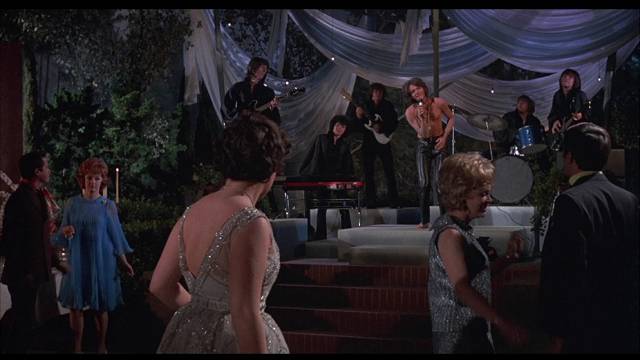
Writer-director Robert Thom’s Cult of the Damned (aka Angel, Angel, Down We Go, 1969) is a scrappy, lower budget version of this, released by American-International Pictures. Surprisingly, the movie was based on an unproduced play Thom wrote around 1960 (the same year he adapted Jack Kerouac’s The Subterraneans for director Ranald MacDougall), so he was either quite prescient or changed it radically to suit new times.
It’s hard to know quite how to take the movie. Shot through with arty montages to give it an up-to-date “psychedelic” vibe, like Skidoo it features old-time Hollywood stars doing things you never expected to see them doing. It’s still a bit of a shock to see David O. Selznick’s protege Jennifer Jones playing a former porn star who has sex with a younger man and says things like “I made thirty stag films and never faked an orgasm.”
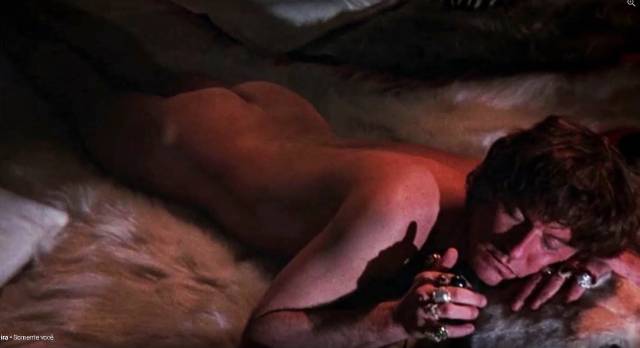
Thom seems to have no empathy for anyone here, not even the protagonist who occasionally narrates through voice-over. This is Tara Nicole Steele (singer-actress Holly Near, sister of Eraserhead’s Lady in the Radiator Laurel Near), daughter of the richest couple in the world, Astrid (Jones) and Willy Steele (Charles Aidman). During the opening stretch, Tara tells us about her wonderful childhood while we see the fat, unhappy girl neglected while her parents attack each other – it’s not a good marriage, she being the libidinous ex-porn actress, he a somewhat closeted homosexual, and yet it’s given some passion by their mutual antagonism. Tara is a bit of an embarrassment, so she’s shipped off to school in Switzerland.
When she returns years later, still fat, her parents remain embarrassed. Nonetheless, they throw a big coming out party for her. The entertainment is a band led by Bogart Peter Stuyvesant (Jordan Christopher) and Tara immediately falls under his sway and that night loses her virginity to him. She hangs out with the band – which includes both Lou Rawls and Roddy McDowall(!) – doing drugs, indulging in sex, and generally giving herself over to hedonism.
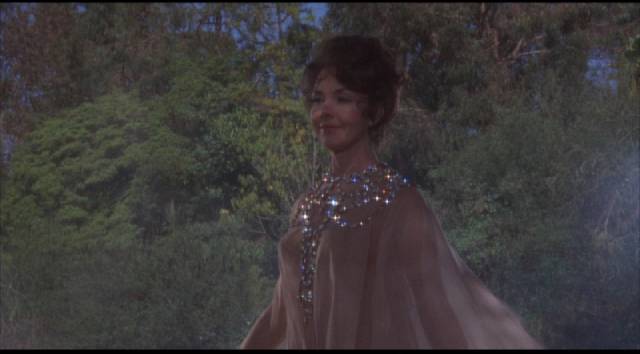
But Bogart seems to have an agenda and, like The Visitor in Pier Paolo Pasolini’s Teorema, proceeds to seduce Astrid and, eventually, Willy as well. Given that the family is already thoroughly decadent (unlike Teorema’s repressed bourgeoisie), there doesn’t seem to be much purpose to his efforts. The movie has nowhere to go, so it becomes little more than an expression of contempt for both a rotten establishment and the nihilists who are determined to overthrow it.
The movie bombed and it remained Thom’s only directorial effort, though he continued to write exploitation scripts for AIP, such as Bloody Mama (1970), Crazy Mama and Death Race 2000 (both 1975). His most interesting work was the second-last film he wrote before his death in 1979 – The Witch Who Came from the Sea (1976), directed by Matt Cimber, which Thom wrote for his wife Millie Perkins. He provided an evocative, even poetic frame for this story of madness, incest and murder; rather than the generalized contempt of Cult of the Damned and the cynicism of many of the exploitation movies, Witch displays genuine empathy for its tormented protagonist.
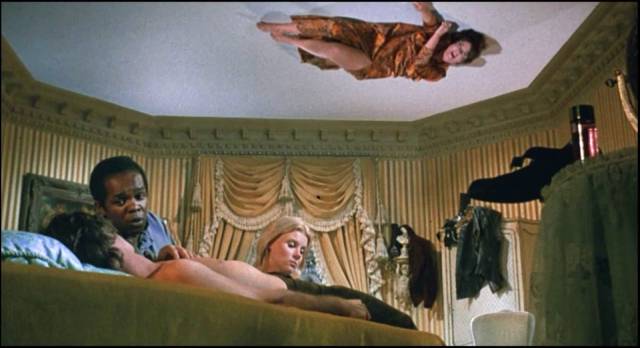
Interestingly, a year after appearing in this, Roddy McDowall directed a much better depiction of decadent wealth and hedonistic youth in The Ballad of Tam Lin (1970), which starred Ava Gardner, who coincidentally was originally considered for the role eventually played by Jennifer Jones in Cult of the Damned.
The image on the Kino Lorber/Scorpion Blu-ray is clean and colourful, and there’s a commentary by Nathaniel Thompson and Tim Greer.
_______________________________________________________________
(1.) One of my favourite scenes from Jack Arnold’s High School Confidential:
(return)
Comments